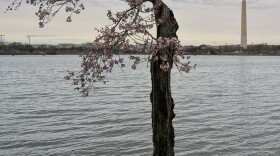Driving along the Rock River, Mitch Leatherbie, a street superintendent for the city of Rockford, Illinois, spots a pair of trees he considers survivors.
“There's two ash trees, right, they're still standing,” said Leatherbie. “... Those were just a couple of them that we kept.”
In the early 2000s, Rockford lost approximately 5,000 ash trees to the emerald ash borer, an invasive beetle. The beetle was first identified in Michigan in 2002 and has since killed tens of millions of ash trees across the country.
The pest left a lasting impression on urban forest managers.
“So what you want to do is focus on diversification of species in an urban forest,” Leatherbie said, “so that when a pest or something comes along, and it focuses on one species, it's not wiping out 20% of your inventory.”

Pests, disease and severe storms are rapidly changing the makeup of urban forests all over the U.S. But adapting is expensive and can be a real barrier for local governments that don’t typically budget with robust urban forests and canopies in mind.
Now trees are getting a windfall.
The Inflation Reduction Act included $1.5 billion of funding over the next nine years dedicated to the Forest Service’s Urban and Community Forestry Program.
“So it's an unprecedented increase, one that is very needed,” said David Sivyer, a regional manager for the U.S. Forest Service. “We'll help to meet many of the chronic challenges that our cities face with respect to extreme heat, flooding, vulnerabilities to storms, that we see increasing in the landscape today.”
As part of the investment, the Forest Service allocated $250 million this year to states and U.S. territories to support local efforts to increase equitable access to urban tree canopy in disadvantaged communities. The Forest Service will distribute another $750 million in grants this year to projects looking to build climate resilient urban forests.
In the past, this kind of funding required a dollar for dollar match, making the application process prohibitively expensive for many communities to participate in. According to Sivyer, the IRA includes provisions that lift the match requirement.
“One-hundred-percent of the work has to be completed in disadvantaged communities, and for that work, the match waiver requirement can be waived,” said Sivyer. “So that will help to put this money to work as quickly as possible.”
That’s exactly what Alan Jankowski, the commissioner of forestry for the city of St. Louis, is counting on. He said that earlier this month there was a nearly 10 degree difference between the parts of the city with ample tree cover and those without it.
His department recently submitted a $50 million dollar proposal to the Forest Service for work like pruning and replacing trees. Jankowski said a proposal that big would be hard to do for the city, if not for the IRA’s waiver eliminating the need for matching funds.
“It would have been very difficult for us to look at the $50 million, for sure.” Jankowski said.

Additionally, the state of Missouri received $1.5 million to implement community forestry work across the state this year — more than five times the state’s budget last year, according to Russell Hinnah, the community forestry coordinator for the Missouri Department of Conservation.
"It's a pretty significant amount," said Hinnah. "Because, usually, we don't see these amounts of money allocated for community forestry practices"
‘Nicety, not a necessity’
A single mature tree can trap some 4,000 gallons of rainwater a year. And the temperature beneath a tree can be up to 25 degrees cooler than its surrounding area.
Yet for many communities, trees have long fallen low on the list of priorities, according to Michael Brunk, the urban and community forestry administrator for the Illinois Department of Natural Resource.
“We've got to build staff,” he said. “We've got to build staff in the urban forestry program — and that's across the board at state and local government at the county level.”
Illinois is slated to receive nearly $14 million from the Forest Service this year. Brunk says that the overall goal in the state is to build capacity for urban forests, and that goes beyond tree inventories, forestry management plants and tree plantings.
As it stands, Brunk is the only employee of the state of Illinois’ urban and community forestry department.
The IRA is giving forestry departments a historic opportunity to recalibrate and prioritize, Brunk said.

For Christina Hoyt, the community landscapes and forest health bureau chief for the Nebraska Forest Service, said in many instances decision makers just haven’t understood the role of trees within their communities, and so urban forestry was overlooked.
“We have communities that are just behind on pruning that needs to happen to help retain trees in our communities,” she said. “We have planting projects that need to be done. In some of our very small communities, adjacent homeowners are responsible for the cost of caring for those trees.”
The Forest Service allocated nearly $1.9 million for Nebraska, which she said will go a long way in helping the state deal with emerald ash borer, first identified in the state in 2016, as well as smaller towns and disadvantaged communities put some focus on trees.
“I think that just having that established funding in our communities, that we can start to experiment and do projects with and help communities do things that they haven't been able to do before,” Hoyt said.
This story was produced in partnership with Harvest Public Media, a collaboration of public media newsrooms in the Midwest. It reports on food systems, agriculture and rural issues.








